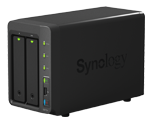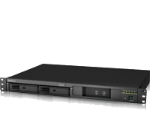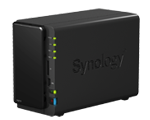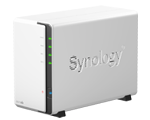RAID 1 in Synology NAS
Good day!
Not so long ago, the user olekl asked us to talk about RAID 1 in Synology, namely
Asked? We answer!
So, 2-disk drives are increasingly in demand among home users and small companies that require a small amount of storage and fault tolerance. In the product line of Synology is presented as many as 7 (seven) 2-disk NAS drives. These are models:
 DS214 + and
DS214 + and  RS214 smb segment
RS214 smb segment
 DS214 soho segment
DS214 soho segment
 DS214play ,
DS214play ,  DS213air ,
DS213air ,  DS213j and
DS213j and  DS214se segment home.
DS214se segment home.
Diagnostics and hot swapping
Synology uses 2 procedures to diagnose hard disk failures: testing the disk surface, launched when a new array is created and later on (as the user wishes) and receiving SMART data in real time. The use of these procedures allows you to track and promptly warn the failure of two discs at the same time.
Often, if you choose the wrong hard drive it takes off from the system. Moreover, the state of the disk surface and its smart remain in order. The reason for such departures is the thoughtfulness of the disk and its non-response within 7 seconds (controller timeout). Therefore, it is better to choose drives NAS or Enterprise series.
If, as a result of diagnostics, Synology issued a warning that the hard drive is defective - it is recommended to replace it. For this, depending on the model of the device, it is necessary to turn off (DS213air, DS213j, DS214se) or simply, on a “hot” disc, eject it. After installing a new disk (and in the DS214play model, you don’t even need to unscrew the screws - the slide for screwless disks) you need to open the Synology web interface, login and open the Storage Manager. Here, we first turn off the sound signal with the corresponding button on the taskbar, and then use the control button to start the partition recovery procedure.
Depending on the size of the disk, it can last from several hours to 1 day.
')
RAID 1 of two drives from different manufacturers.
Everything is simple here: working on a smaller / slow disk.
Since RAID 1 implies simultaneous recording on both disks, when installing a slow and fast drive in one partition, the fast one will constantly wait until a slow companion has added it. Such configurations are viable, but not recommended for use .
Synology device failure, data recovery from disks.
It is highly unlikely, but still Synology can fail: improper shutdown (on power), physical impact, or just an accident. At this point, the user must first ensure that the data is in order. So, what about the disks? Everything is very simple:
Section 1 - DSM OS itself, is combined into RAID 1, regardless of the number of bays in the device.
Section 2 - swap, typical of all linux OSes
Section 3 - User Data. The most important for you and for NAS section :)
When using RAID 1, a regular ext4 partition is created on the disk where the data falls. Mounted in the system as / volume1
By connecting the disk from Synology to a PC under Linux, we will see all 3 partitions and can safely pull out the data.
If you are not familiar with Linux, then we connect the disk to a PC under Windows , download and run UFS Explorer Professional Recovery and read our data (alas, this ext4 program does not know how to write).
Also a fresh solution is the ability to build a High Availability cluster from two identical devices. From dual drive it is only DS713 +.
In fact, when building this cluster, we get almost RAID 1 of two devices (“almost” because the transition time from active to passive is about 40 seconds). Read more at synology.com
And finally: installing hard disks from your old Synology to a new one, you can read all the data stored on these disks. In some cases, you will need to migrate.
The thg.ru website publishes a series of articles telling about Synology NAS and their configuration. By reference - Lesson 4, All about using RAID.
I hope everything is clear and simple. If you have any questions, I will be happy to answer them in the comments or by calling Synology Support:
+7 (499) 704-4539 for Moscow
8 (804) 333-4601 for the regions of Russia (free call)
Not so long ago, the user olekl asked us to talk about RAID 1 in Synology, namely
- raid 1, single disk failure, diagnostic and hot-swap procedure
- raid 1 of two disks of different manufacturers
- raid 1, failure of the device itself, data rescue from disk by means of OS
Asked? We answer!
So, 2-disk drives are increasingly in demand among home users and small companies that require a small amount of storage and fault tolerance. In the product line of Synology is presented as many as 7 (seven) 2-disk NAS drives. These are models:
 DS214 + and
DS214 + and  RS214 smb segment
RS214 smb segment DS214 soho segment
DS214 soho segment DS214play ,
DS214play ,  DS213air ,
DS213air ,  DS213j and
DS213j and  DS214se segment home.
DS214se segment home.Diagnostics and hot swapping
Synology uses 2 procedures to diagnose hard disk failures: testing the disk surface, launched when a new array is created and later on (as the user wishes) and receiving SMART data in real time. The use of these procedures allows you to track and promptly warn the failure of two discs at the same time.
Often, if you choose the wrong hard drive it takes off from the system. Moreover, the state of the disk surface and its smart remain in order. The reason for such departures is the thoughtfulness of the disk and its non-response within 7 seconds (controller timeout). Therefore, it is better to choose drives NAS or Enterprise series.
If, as a result of diagnostics, Synology issued a warning that the hard drive is defective - it is recommended to replace it. For this, depending on the model of the device, it is necessary to turn off (DS213air, DS213j, DS214se) or simply, on a “hot” disc, eject it. After installing a new disk (and in the DS214play model, you don’t even need to unscrew the screws - the slide for screwless disks) you need to open the Synology web interface, login and open the Storage Manager. Here, we first turn off the sound signal with the corresponding button on the taskbar, and then use the control button to start the partition recovery procedure.
Depending on the size of the disk, it can last from several hours to 1 day.
')
RAID 1 of two drives from different manufacturers.
Everything is simple here: working on a smaller / slow disk.
Since RAID 1 implies simultaneous recording on both disks, when installing a slow and fast drive in one partition, the fast one will constantly wait until a slow companion has added it. Such configurations are viable, but not recommended for use .
Synology device failure, data recovery from disks.
It is highly unlikely, but still Synology can fail: improper shutdown (on power), physical impact, or just an accident. At this point, the user must first ensure that the data is in order. So, what about the disks? Everything is very simple:
Section 1 - DSM OS itself, is combined into RAID 1, regardless of the number of bays in the device.
Section 2 - swap, typical of all linux OSes
Section 3 - User Data. The most important for you and for NAS section :)
When using RAID 1, a regular ext4 partition is created on the disk where the data falls. Mounted in the system as / volume1
By connecting the disk from Synology to a PC under Linux, we will see all 3 partitions and can safely pull out the data.
If you are not familiar with Linux, then we connect the disk to a PC under Windows , download and run UFS Explorer Professional Recovery and read our data (alas, this ext4 program does not know how to write).
Also a fresh solution is the ability to build a High Availability cluster from two identical devices. From dual drive it is only DS713 +.
In fact, when building this cluster, we get almost RAID 1 of two devices (“almost” because the transition time from active to passive is about 40 seconds). Read more at synology.com
And finally: installing hard disks from your old Synology to a new one, you can read all the data stored on these disks. In some cases, you will need to migrate.
The thg.ru website publishes a series of articles telling about Synology NAS and their configuration. By reference - Lesson 4, All about using RAID.
I hope everything is clear and simple. If you have any questions, I will be happy to answer them in the comments or by calling Synology Support:
+7 (499) 704-4539 for Moscow
8 (804) 333-4601 for the regions of Russia (free call)
Source: https://habr.com/ru/post/205384/
All Articles